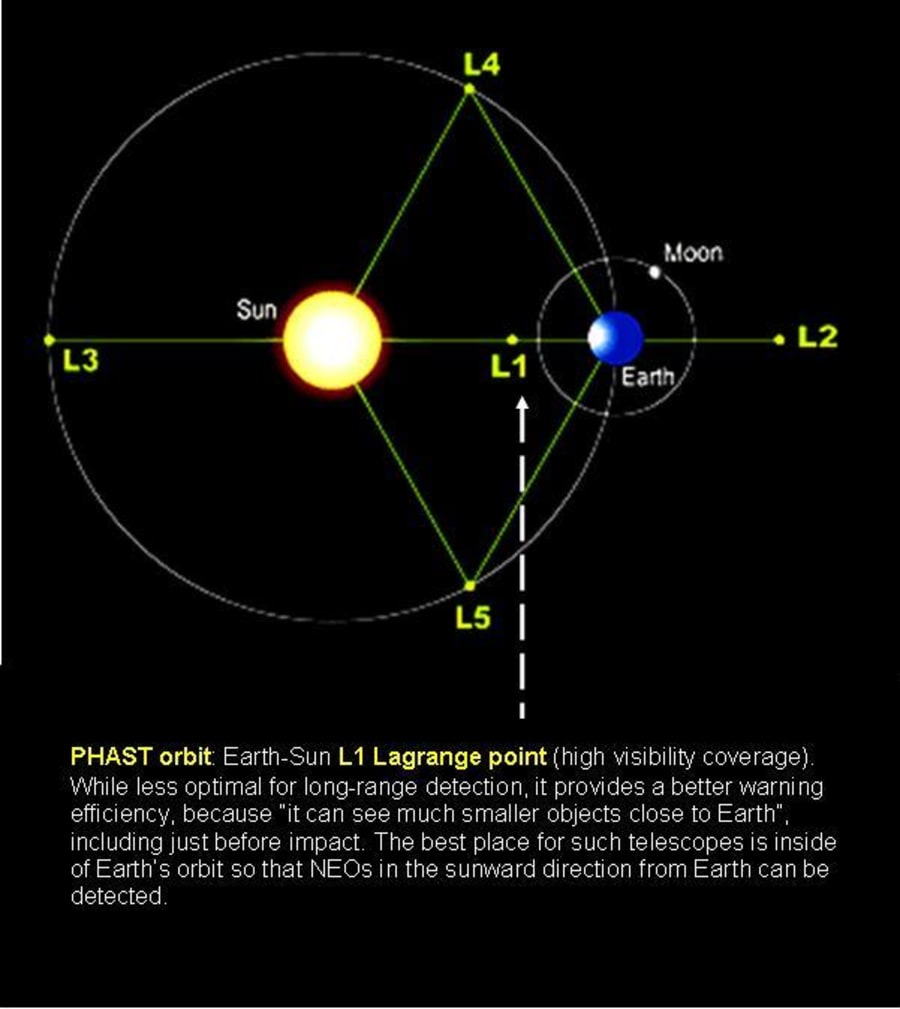Potentially Hazardous Asteroids Space Telescope (PHAST), a proposal for asteroid detection, tracking, and characterization.
Near-Earth asteroids (NEAs), also called near-Earth objects (NEOs), orbit the sun, like all asteroids, but their paths bring them “close” to Earth (within about 45 million kilometers). Scientists estimate that they've found about 95 percent of the potential "civilization-enders" .Until today 1488 of these NEOs have been classified as Potentially Hazardous Asteroids (PHAs). This specific definition defines any asteroid with an Earth Minimum Orbit Intersection Distance (MOID) of 0.05 AU or less and an absolute magnitude (H) of 22.0 or less. The biggest challenge now is finding the smaller ones: down to 100 meters, and down to 40 meters. On impact, these could destroy part of a continent, or a city. “There are something like a million 40-meter NEAs” and until now we’ve found less than 1%.
My proposal briefly describes how to discover, track and characterize all possible potentially hazardous asteroids that are near the Earth. To do that, we should think about “a network of detection” involving both space-based and ground-based observatories, that will alert observers when asteroids or comets are on a collision course with Earth. This will allow disaster professionals time to prepare a course of action to avert as much danger as possible.
PHAST, with its exceptional characteristics, it could be “the heart of this network”. Some of its main characteristics (detection part) are:
Two wide-field cameras, operating at thermal infrared wavelengths.
The imaging sensors should be from ternary semiconductors. Their special properties can provide the necessary desired specifications. They should operate comfortably at about 40 degrees above absolute zero, the temperature at which most space-based telescopes eventually live out their lives in space. The ability to operate at 40 degrees Kelvin means that PHAST would not have to carry an artificial coolant (cryogen), such as liquid helium or solid hydrogen, a requirement for silicon-based arrays. The main benefit is that they can enable the mission to have a very long life.
The detectors should be capable of capturing much more than 20 megapixels of light.
Wavelength operation of the wide field imager: from 3?m – 15?m. Detectors cutoff wavelength: ~15?m
Pixels meeting dark current spec: >90%
Format: more than 1024X1024
Camera Operability: ~ 40K
Quantum efficiency: >65%
PHAST orbit: Earth-Sun L1 Lagrange point (high visibility coverage). While less optimal for long-range detection, it provides a better warning efficiency, because “it can see much smaller objects close to Earth”, including just before impact. The best place for such telescopes is inside of Earth’s orbit so that NEOs in the sunward direction from Earth can be detected.
PHAST from space in combination with ground-based observatories, such as the Large Synoptic Survey Telescope (LSST) and the Asteroid Terrestrial-impact Last Alert System (ATLAS)… , it could be the best solution we are seeking for. Additionally, any coordinated globally collaboration with observatories, including the amateur astronomers as part of the global asteroid hunt; it will be a great plus to reach the goal.
Voting
-
ABOUT THE ENTRANT
- Name:Anthony Ponirakis
- Type of entry:individual
- Profession:
- Number of times previously entering contest:3
- Anthony's favorite design and analysis tools:SolidWorks 3D CAD Software, Silvaco's ATLAS software.
- Anthony's hobbies and activities:Astronomy, philosophy, reading, photography, ....
- Anthony belongs to these online communities:None
- Software used for this entry:SolidWorks 3D CAD Software
- Patent status:none





